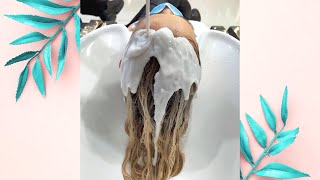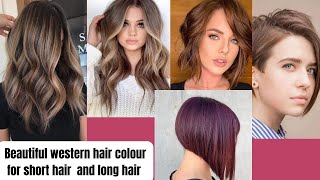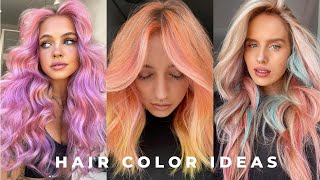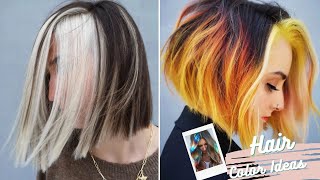Learn How Hair Color Works To Understand The Risks

Hair color is a fabulous way to change your style and us women have been changing our hair color for hundreds of years. Romans applied colored paste with lime to their locks to change the color but in 1907 L’Oreal’s Eugene Schueller invented the reliable synthetic hair dyes we know today and we have been going crazy for color ever since.
Coloring your hair is achieved in two ways: either bleaching or staining.
Bleaching To Go Lighter
If you have darker hair and want to go lighter, you have to remove the color already in your hair. This is commonly done using hydrogen peroxide which reacts with melanin (the color molecules in your hair) rendering it permanently colorless.
How much color is removed depends on the strength of the peroxide used and whether an alkalizing agent like ammonia is used. Ammonia is an alkaline that opens the cuticles to allow the bleach into the hair shaft and react with even more melanin.
During the application of the alkaline ammonia, hair swells which weakens it substantially. This is why black women who relax their hair are advised against coloring their hair as well.
Hair relaxers are also alkaline so relaxed hair has already weakened from the swelling during the relaxing process. Coloring on top of that would irreparably damage the hair fiber and intense breakage becomes inevitable after that.
If virgin hair is colored with an alkalizing agent, although it won’t change the natural structure of the hair (curls remain the same), the chemical process may leave the hair weaker than it was before due to loss of protein during the coloring process. This is why a color stylist will advise you against going too light if your natural hair color is very dark brown to black.
Once the hair is bleached, it is then stained with the coloring agent to give the desired result. Many box colors do this is a single step but many color stylists may do them as separate processes.
Staining To Go Darker
Going darker involves adding color to your hair, essentially your hair gets stained by the color applied. Semi permanent colors sit on the outside of your hair shaft and wash out with a few shampoos.
Permanent colors on the other hand have molecules that are small enough to get inside the hair shaft. Once inside the hair shaft, there they react with each other to create polymers that would then be too big to get out of the shaft.
Unfortunately every time you get your hair wet, it swells with water especially if your hair has high porosity and as a result you will find that even permanent hair colors can get washed out and lose their vibrancy after a few shampoos.
For this reason, shampoos specifically made for colored hair are advisable to keep your color vibrant and reduce the number of times that you need to re-color your hair.
 Natural Hair Dyes
Natural Hair Dyes
Natural based hair dyes like henna work in a very similar way to permanent hair color. The active ingredient in henna is Lawsone, a molecule which has a very high affinity to the keratin in our hair and skin.
When applied to hair it creates a permanent bond that cannot be stripped from the hair or skin. If you have ever had a henna* tattoo you will notice that it fades little by little over time. This is less to do with the dye being washed off than your skin cells shedding and being replaced by new cells.
Like other permanent colors it may fade a little over time but you cannot completely strip henna from your hair so in that way it also causes a permanent change to your hair.
Some ladies with very tight curl patterns will experience some loosening of their curls if henna* is used regularly. This happens as more and more Lawsone bonds with the keratin in their hair. If you do not like the idea of your curl pattern being permanently change then I would advise you to stay away from henna too.
Potential Risks Of Permanent Color
Now we know how hair is colored and you now know how to care for it if you do decide to go down this route (extra protein regularly). If you are relaxed, the only thing I can say is attempting to bleach your hair will probably lead to breakage so don’t do it!
Of course there are always exceptions to the rule and I have seen a few relaxed & hair lightened women manage to get BSL length but these ladies are the exception rather than the rule so visit a color stylist who will assess your hair and determine if it’s worth the risk or not.
Personally I believe that you are better of growing your hair to your goal length first before experimenting and even then, start off with bleaching a few streaks of hair (highlights) and see how your hair handles that before committing all your hair to a color change.
For natural ladies, I also recommend a color stylist as the first point of call. Color is not to be taken lightly so I don’t recommend at home permanent box colors. Things can go all to wrong if you don’t plan changes to your regimen to accommodate the changes in your hair strength and a color stylist will be able to advise you on what is best for your hair or in fact if your hair is healthy enough to be colored.
Why It May Be Risky To Color
If you do bleach your hair you must be regular with your protein treatments. Even if you are natural your hair has gone through very similar stress to the relaxer process so it will be requiring added strength regularly to prevent breakage and dryness caused by the increase in porosity.
There is also the potential allergic reaction to permanent staining hair dyes that some ladies may not be aware of and also there does seem to be some evidence to suggest that some colors contain PPD’s which are a potential carcinogen and health risk for those exposed to them.
So to color or not to color, that is the question…




